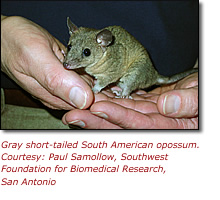Last updated: September 16, 2012
Researchers Publish First Marsupial Genome Sequence

National Human Genome Research Institute
www.genome.gov
Researchers Publish First Marsupial Genome Sequence
Comparison to Human Genome Shows "Junk" DNA As Creative Force in Genetic Innovations
 BETHESDA, Md., Wed., May 9, 2007 — An international team, led by researchers at the Broad Institute of MIT and Harvard, and supported by the National Institutes of Health (NIH), today announced the publication of the first genome of a marsupial, belonging to a South American species of opossum. In a comparison of the marsupial genome to genomes of non-marsupials, including human, published in the May 10 issue of the journal Nature, the team found that most innovations leading to the human genome sequence lie not in protein-coding genes, but in areas that until recently were referred to as "junk" DNA.
BETHESDA, Md., Wed., May 9, 2007 — An international team, led by researchers at the Broad Institute of MIT and Harvard, and supported by the National Institutes of Health (NIH), today announced the publication of the first genome of a marsupial, belonging to a South American species of opossum. In a comparison of the marsupial genome to genomes of non-marsupials, including human, published in the May 10 issue of the journal Nature, the team found that most innovations leading to the human genome sequence lie not in protein-coding genes, but in areas that until recently were referred to as "junk" DNA.
The effort to generate the high-quality genome sequence of the gray short-tailed, South American opossum, Monodelphis domestica, began in 2003 and cost approximately $25 million. The sequencing work was funded by the National Human Genome Research Institute (NHGRI), part of the NIH, and carried out at the Broad Institute Sequencing Platform, which is a member of NHGRI's Large-Scale Sequencing Research Network.
"The opossum genome occupies a unique position on the tree of life. This analysis fills a crucial gap in our understanding of how mammalian genomes, including our own, have evolved over millions of years," said NHGRI Director Francis S. Collins, M.D., Ph.D. "These new findings illustrate how important it is to understand all of the human genome, not just the fraction that contains genes that code for proteins. We must identify all functional elements in the genome if we are to have the most complete toolbox possible to explore human biology and improve human health."
Marsupials are unique among mammals because their young are born at an extremely early stage of development, attach to their mother's teats and complete their subsequent development while in a protective pouch. This makes the young readily available for early developmental research.
There are many other areas of biomedical research for which Monodelphis serves as a model. For example, it is the only laboratory animal known in which ultraviolet radiation alone can cause melanoma, a type of skin cancer that also strikes humans exposed to too much of the sun's ultraviolet rays. Having the sequence of the opossum genome will give researchers the ability to learn more about the molecular basis of melanoma and its progression, as well as explore development of new therapies and preventive treatments.
The opossum genome sequence also provides researchers with a fresh perspective on the evolutionary origins of the human genome. It sheds light on the genetic differences between placental mammals, such as humans, mice and dogs, and marsupial mammals, such as opossums and kangaroos.
"Marsupials are the closest living relatives of placental mammals. Because of this relationship, the opossum genome offers a unique lens though which to view the evolution of our own genome," said Kirstin Lindblad-Toh, Ph.D., co-director of the Broad Institute's genome sequencing and analysis program and the study's senior author.
Marsupials and the ancestors of placental mammals diverged 180 million years ago. By comparing the opossum and human genomes, researchers were able to pinpoint genetic elements that are present in placental mammals, but missing from marsupials - that is, the genetic factors that may underlie many of the differences between the two types of mammals.
Interestingly, about one-fifth of the key functional elements in the human genome arose during this relatively recent evolutionary period. By focusing on the recent genetic innovations, the scientists made two major findings:
- First, the vast majority (about 95 percent) of recent genetic innovation lies not in protein-coding genes, but in regions of the genome that do not contain genes and that many had referred to as junk DNA until recently. Researchers now know that junk DNA may contain regulatory elements that influence the activity of nearby genes, but the full extent of the importance of these non-gene regions is still being revealed. The new results suggest that mammals evolved not so much by inventing new kinds of proteins, as by tweaking the molecular controls that dictate when and where proteins are made.
- Second, many of the new DNA instructions appear to be derived from transposons, or "jumping genes," which are also located in areas once thought to be junk DNA.
"Transposons have a restless lifestyle, often shuttling themselves from one chromosome to another," said the study's first author Tarjei Mikkelsen, a Broad Institute researcher. "It is now clear that in their travels, they are disseminating crucial genetic innovations around the genome."
Other important findings to emerge from the analysis of the opossum genome include:
- The opossum has many genes involved in immunity, challenging the notion that marsupials possess only primitive immune systems.
- The opossum genome has an unusual structure with fewer chromosomes than the human genome (9 pairs versus 23 pairs, respectively) but a longer total length (3.4 billion versus 3 billion bases, respectively).
The opossum and human genome sequences, along with those of a wide range of other organisms such as mouse, rat, dog, chimpanzee, rhesus macaque, orangutan, cow, honey bee, fruit fly, roundworm and yeast, can be accessed through the following public genome browsers: GenBank (www.ncbi.nih.gov/Genbank) at NIH's National Center for Biotechnology Information (NCBI); the UCSC Genome Browser (www.genome.ucsc.edu) at the University of California at Santa Cruz; the Ensembl Genome Browser (www.ensembl.org) at the Wellcome Trust Sanger Institute and the EMBL-European Bioinformatics Institute; the DNA Data Bank of Japan (www.ddbj.nig.ac.jp); and EMBL-Bank, (www.ebi.ac.uk/embl/index.html) at the European Molecular Biology Laboratory's Nucleotide Sequence Database.
A high-resolution photo of the South American opossum is available at: www.genome.gov/dmd/img.cfm?node=Photos/Animals/Opossum%20(short_tailed)&id=79128.
NHGRI is one of the 27 institutes and centers at the NIH, an agency of the Department of Health and Human Services (DHHS). Additional information about NHGRI can be found at its Web site, www.genome.gov.
The National Institutes of Health - "The Nation's Medical Research Agency" - includes 27 institutes and centers, and is a component of the U.S. Department of Health and Human Services. It is the primary federal agency for conducting and supporting basic, clinical and translational medical research, and it investigates the causes, treatments, and cures for both common and rare diseases. For more, visit www.nih.gov.
Contact
Geoff Spencer
NHGRI
301-402-0911
spencerg@mail.nih.gov
Nicole Davis, Ph.D.
Broad Institute of MIT and Harvard
617-258-0952
ndavis@broad.mit.edu
